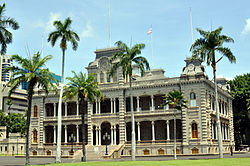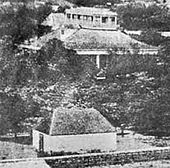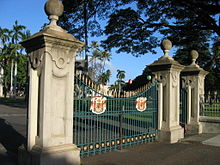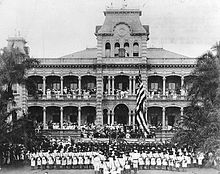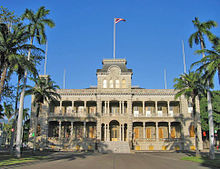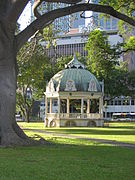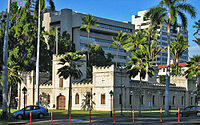- ʻIolani Palace
-
ʻIolani PalaceʻIolani Palace is the hallmark of Hawaiian renaissance architecture
Location: Honolulu, HI Coordinates: 21°18′23.84″N 157°51′32.25″W / 21.3066222°N 157.8589583°WCoordinates: 21°18′23.84″N 157°51′32.25″W / 21.3066222°N 157.8589583°W Area: 10.6 acres (4.3 ha) Built: 1879 Architect: Thomas J. Baker, Charles J. Wall, Isaac Moore Architectural style: American Florentine Governing body: State of Hawaii Part of: Hawaii Capital Historic District (#78001020) NRHP Reference#: 66000293[1] Significant dates Added to NRHP: October 15, 1966 Designated NHL: December 29, 1962[2] ʻIolani Palace, in the capitol district of downtown Honolulu in the U.S. state of Hawaiʻi, is the only royal palace in the United States used as an official residence by a reigning monarch and is a National Historic Landmark listed on the National Register of Historic Places. Two monarchs governed from ʻIolani Palace: King Kalākaua and Queen Liliʻuokalani. After the monarchy was overthrown in 1893, the building was used as the capitol building for the Provisional Government, Republic, Territory, and State of Hawaiʻi until 1969. The palace was restored and opened to the public as a museum in 1978.
Contents
History
Pohukaina
In the early 19th-century, this area was known as Pohukaina,[3] probably from pohu ka ʻāina which in the Hawaiian language means "the land is calm".[4] It may also been named for the chief of the same name (sometimes spelled Pahukaina) who was from Hawaii island. The land was to Kekauluohi, who later ruled as Kuhina Nui, as her birthrights.[5]
The missionary Hiram Bingham I was allowed to build a missionary compound of his house and what became the Kawaiahaʻo Church outside of the old town. Some thatched huts were built for royalty to be near a school that the missionaries ran for the royal family at the church. Another missionary William Ellis built his home there, and Prime Minister Kalanimoku decided to build the first stone house on the site, naming it "Pohukaina". After Kalanimoku's death, the building, often referred to as a palace, became the meeting hall for the council of chiefs.[5] The present palace grounds consist of many different homes for other aliʻis; Kekūanāoa build his house Haliʻimaile and Keoni Ana lived in Kīnaʻu Hale, which was later converted into the residence of the royal chamberlain, on the site.
Oral history told of an ancient heiau (temple to the Hawaiian religion) called Kaʻahaimauli that was destroyed in the area.[6][7]
After 1825, the first Western-style royal tomb was constructed for the bodies of King Kamehameha II and his queen Kamāmalu. They were buried on August 23, 1825. The idea was heavily influenced by the tombs at Westminster Abbey during Kamehameha II's trip to London. The mausoleum was a small house made of coral blocks with a thatched roof. It had no windows, and it was the duty of two chiefs to guard the iron-locked koa door day and night. No one can enter the vault except for burials or Memorial Day, a Hawaiian national holiday celebrated on December 30.[5]
Although Kamehameha III lived in the compound for a while, he had no permanent capital, and left in 1837 for Maui.[8] Over time, as more bodies were added, the small vault became crowded, so other chiefs and retainers were buried in unmarked graves nearby. In 1865 a selected 20 coffins were removed to the Royal Mausoleum of Hawaii called Mauna ʻAla in Nuʻuanu Valley. But many chiefs remain on the site including: Keaweikekahialiʻiokamoku, Kalaniopuu, Chiefess Kapiolani, and Timothy Haalilio.
After being overgrown for many years, the Hawaiian Historical Society passed a resolution in 1930 requesting Governor Lawrence Judd to memorialize the site with the construction of a metal fence enclosure and a plaque. Tradition holds that the tomb was on the site of a former cave.[5][9]
Hale Aliʻi
The ʻIolani Palace structure that exists today is actually the second to sit on the grounds. The original one story wooden building called Hanailoia was built in July 1844, only one-third the floor area of the present palace. Mataio Kekūanāoʻa, who was long-time Royal Governor of Oʻahu, built it for his daughter Princess Victoria Kamāmalu. It was purchased by King Kamehameha III from Kamāmalu (the King's niece) when he moved his capital from Lahaina to Honolulu in 1845. Kekūanāoʻa built his own house directly to the west, and Kekāuluohi built hers to the south near the Pohukaina mausoleum.[6]
It was constructed as a traditional aliʻi residence with only ceremonial spaces, no sleeping rooms. It just had a throne room, a reception room, and a state dining room, with other houses around for sleeping and for retainers. Kamehameha III slept in a cooler grass hut around the palace. He called his home Hoʻihoʻikea[10] in honor of his restoration after the Paulet Affair of 1843.[6]
The palace building was named Hale Aliʻi meaning (House of the Chiefs). During Kamehameha V's reign it was changed to ʻIolani Palace, after his brother Kamehameha IV's given names (his full name was Alexander Liholiho Keawenui ʻIolani). It literally means "royal hawk." The Palace served as the official residence of the monarch during the reigns of Kamehameha IV, Kamehameha V, Lunalilo, and the first part of Kalākaua's reign.[11] The original structure was very simple in design and was more of a stately home than a palace, but at the time, it was the grandest house in town. The palace was largely meant for receiving foreign dignitaries and state functions; the king prefered to live in grass huts on the palace grounds.
Theodore Heuck, who had earlier designed the new Mausoleum, designed a building called ʻIolani Barracks, completed in 1871, to house the royal guards. Over time the other houses on the grounds were removed and replaced with grass lawns.
Second Palace
King Kamehameha V envisioned a royal palace befitting of the sovereignty of a modern state. He commissioned the construction of Aliʻiōlani Hale to be the official palace of the Hawaiian monarchy. The building was constructed across the street from the original ʻIolani Palace structure. It was named after himself (his full name was Lot Kapuaiwa Kalanikupuapaikalaninui Aliʻiolani Kalanimakua) it means "House of the heavenly King". At the time, Hawaiʻi sorely needed a government building, since the government buildings of the time were small and cramped. Ultimately, Aliʻiōlani Hale became an administrative building instead of a palace, housing the judiciary of the Kingdom of Hawaiʻi and various other ministries.
By the time David Kalākaua assumed the throne, the original ʻIolani Palace was in poor condition, suffering from ground termite damage. He ordered the old palace to be razed.
Kalākaua was the first monarch to travel around the world. While visiting Europe, he took note of the grand palaces owned by other monarchs. Like Kamehameha V, he dreamed of a royal palace befitting of the sovereignty of a modern state such as Hawaiʻi. He commissioned the construction a new ʻIolani Palace, directly across the street from Aliʻiōlani Hale, to become the official palace of the Hawaiian monarchy.
Thomas J. Baker designed the structure, Charles J. Wall added details, and architect Isaac Moore. The cornerstone was laid December 31, 1879 during the administration of Minister of the Interior Samuel Gardner Wilder.[12]:204 It was built of brick with concrete facing. The building was completed in November 1882 and cost over $340,000 — a vast fortune at the time. It measures about 140 feet (43 m) by 100 feet (30 m), and rises two stories over a raised basement to 54 feet (16 m) high. It has four corner towers and two in the center rising to 76 feet (23 m). On February 12, 1883 a formal European-style coronation ceremony was held, even though Kalākaua had reigned for 9 years. The coronation pavilion was later moved to the southwest corner of the grounds and converted to a bandstand for the Royal Hawaiian Band.[11]
ʻIolani Palace features architecture seen nowhere else in the world. This unique style is known as American Florentine. On the first floor a grand hall faces a staircase of koa wood. Ornamental plaster decorates the interior. The throne room (southeast corner), the blue meeting room, and the dining room adjoin the hall. The blue room included a large 1848 portrait of King Louis Philippe of France and a koa wood piano where Liliʻuokalani played her compositions for guests. Upstairs are the private library and bedrooms of the Hawaiian monarchs.[11] It had electricity and telephones even before the White House.
It served as the official residence of the Hawaiian monarch until the 1893 overthrow of the Kingdom of Hawaii. Beside Liliʻuokalani, Queen Kapiʻolani and other royal retainers were evicted from the palace after the overthrow.
Executive Building
Upon the overthrow of the monarchy by the Committee of Safety in 1893, troops of the newly formed Provisional Government of Hawaiʻi took control of ʻIolani Palace. After a few months government offices moved in and it was renamed the "Executive Building" for the Republic of Hawaiʻi. Government officials carefully inventoried its contents and sold at public auctions whatever furniture or furnishings were not suitable for government operations. Queen Liliʻuokalani was imprisoned for nine months in a small room on the upper floor after the second of the Wilcox rebellions in 1895. The quilt she made is still there. The trial was held in the former throne room.[11]
When a proposed annexation treaty up for ratification, the Hawaiian Patriotic League held a protest rally at the palace on September 6, 1897. They gathered petition signatures in an effort to demonstrate the treaty did not have popular support. On August 12, 1898 US troops from the USS Philadelphia came ashore and raised the Flag of the United States at the palace to mark the annexation by the Newlands Resolution. The Queen and other Hawaiian nobles did not attend, staying at Washington Place instead.[13] The building served as the capitol of the Territory of Hawaiʻi, the military headquarters during World War II, and the State of Hawaiʻi.During the government use of the palace, the second floor royal bedroom became the governor's office, while the legislature occupied the entire first floor. The representatives met in the former throne room and the senate in the former dining room.[11]
Archives
After annexation, there was a fear that all records would be moved to the mainland. Since an 1847 effort by Robert Crichton Wyllie, a set of archives had been kept of all kingdom records. A new fireproof building was built in 1906 on the grounds just to the southeast of the palace. It included a vault 30 feet (9.1 m) by 40 feet (12 m) with steel shelves. At first it was to be called the Hall of Records, but the name Archives of Hawaii made it clear the documents included those from the kingdom.[14] A new Kekāuluohi building provides digital access to some of the collections.[15]
Palace Restoration
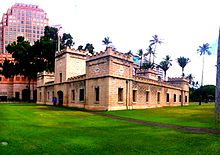 ʻIolani Barracks housed royal guards
ʻIolani Barracks housed royal guards
In 1930 the interior of ʻIolani Palace was remodeled, and wood framing replaced by steel and reinforced concrete. The name ʻIolani Palace was officially restored in 1935.[11] During World War II, it served as the temporary headquarters for the military governor in charge of martial law in the Hawaiian Islands.
The Hawaiian soldiers of Japanese ancestry who were accepted for service in the US Army became the core of the 442nd Infantry Regiment. Before leaving Hawaii for training on the mainland, they were sworn in during a mass ceremony on the grounds of the Palace.[16]
Through more than 70 years as a functional but neglected government building, the Palace fell into disrepair. After Hawaii became a state, Governor John A. Burns began an effort to restore the palace in the 1960s. The first step was to move the former ʻIolani Barracks building from its original position northeast of the palace. It now serves as a visitors center for the palace.
ʻIolani Palace was designated a National Historic Landmark on December 29, 1962[2] and added as site 66000293 to the National Register of Historic Places listings in Oahu on October 15, 1966.[1] Government offices vacated the Palace in 1969 and moved to the newly constructed Hawaii State Capitol building on the former barracks site. In preparation for restoration, the Junior League of Honolulu researched construction, furnishings, and palace lifestyle in nineteenth-century newspapers, photographs and archival manuscripts. Overseeing the restoration was The Friends of ʻIolani Palace, founded by Liliʻuokalani Kawānanakoa Morris, grand-niece of Queen Kapiʻolani. Two wooden additions were removed and the interior was restored based on original plans.[17]Through the efforts of acquisitions researchers and professional museum staff, and donations of individuals, many original Palace objects have been returned. Government grants and private donations funded reproduction of original fabrics and finishes to restore Palace rooms to their monarchy era appearance. ʻIolani Palace opened to the public in 1978 after structural restoration of the building was completed.[17] In the basement is a photographic display of the Palace, the Hawaiian crown jewels, orders and decorations given by the monarchs, and regalia worn by the high chiefs of the islands.
The grounds of ʻIolani Palace are managed by the Hawaiʻi State Department of Land and Natural Resources but the palace building itself is managed as a historical house museum by the Friends of ʻIolani Palace, a non-profit non-governmental organization. The birthdays of King Kalākaua (November 16) and Queen Kapiʻolani (December 28) are celebrated with ceremonies.[18]
Recent events
On January 17, 1993, a massive observation was held on the grounds of ʻIolani Palace to mark the 100th anniversary of the overthrow of the Hawaiian monarchy. A torchlight vigil was held at night, with the palace draped in black.[19]
On April 30, 2008, ʻIolani Palace was overtaken by a group of native Hawaiians who called themselves the Hawaiian Kingdom Government to protest what they view as illegitimate rule by the United States. Mahealani Kahau, "head of state" of the group, said they do not recognize Hawaiʻi as a U.S. state, but would keep the occupation of the palace peaceful. "The Hawaiian Kingdom Government is here and it doesn't plan to leave. This is a continuity of the Hawaiian Kingdom of 1892 to today," Kahau said.[20][21]
In response, the Friends of ʻIolani Palace released a statement that while they "respect the freedom of Hawaiian groups to hold an opinion on the overthrow of the Hawaiian Kingdom, we believe that blocking public access to Iolani Palace is wrong and certainly detrimental to our mission to share the Palace and its history with our residents, our keiki (children), and our visitors."[22] The statement clarified that the original seat of government of the Hawaiian Kingdom was not ʻIolani Palace. The Palace was used as the royal residence while government activities were carried out in the original courthouse (now demolished) and later in Aliʻiolani Hale.[23]
In fiction
The fictional TV series, Hawaii Five-O, had state police headquarters based in ʻIolani Palace. Fans of the series are led to believe that the office of the leader of the fictional state police force, Steve McGarrett, is located in the upper right corner (when viewed from outside). The 1968-1980 police drama, in fact, was filmed on location in Hawaii, and many scenes were filmed in the Iolani Palace. ʻIolani Palace plays a significant role in the Harry Turtledove books Days of Infamy and End of the Beginning as the seat of the Japanese puppet government of Hawaiʻi. A movie titled Princess Kaiulani about Princess Kaʻiulani was filmed at the palace in 2008.[24][25] A fictional character claiming to work for the ʻIolani Palace restoration project and trying to recover presents Queen Kapiʻolani gave to Boston residents on her stay there in 1887 plays a significant role in Charlotte MacLeod's detective fiction The Withdrawing Room (1981).[citation needed]
Images
Hawaiian Coat of Arms on ʻIolani Palace GateʻIolani Hawk, the high flight of the hawk signified Hawaiian Royalty.Coronation Pavilion for King Kalakaua and Queen Kapiʻolani in 1883References
- ^ a b "National Register Information System". National Register of Historic Places. National Park Service. 2007-01-23. http://nrhp.focus.nps.gov/natreg/docs/All_Data.html.
- ^ a b "Iolani Palace". National Historic Landmark summary listing. National Park Service. http://tps.cr.nps.gov/nhl/detail.cfm?ResourceId=184&ResourceType=Building. Retrieved 2008-06-21.
- ^ U.S. Geological Survey Geographic Names Information System: Pohukaina
- ^ Mary Kawena Pukui and Elbert (2003). "lookup of pohu". on Hawaiian dictionary. Ulukau, the Hawaiian Electronic Library, University of Hawaii. http://wehewehe.org/cgi-bin/hdict?e=q&a=q&l=en&q=pohu&d=D18307. Retrieved 2010-03-01.
- ^ a b c d The Friends of ʻIolani Palace (2001). "Ka Pa Aliʻi: Protecting This Sacred Place: September 8, 2001 - Old Archives Building". http://www.protecting_this_sacred_place.pdf. Retrieved 2010-04-10.
- ^ a b c John M. Kapena (1906). "Hawaiian National Reminiscences". Hawaiian Almanac and Annual: pp. 74–81. http://books.google.com/books?id=g55P5fZmSB0C&pg=PA74. (extracts of address at cornerstone ceremony in 1879)
- ^ http://www.hawaiialive.org/viewer.php?resource=622&hostType=sub&hostID=122
- ^ Jim Bartels (2003). "ʻIolani Palace". Pacific Worlds web site. http://www.pacificworlds.com/nuuanu/native/native4.cfm. Retrieved 2010-04-06.
- ^ Jim Bartels (2003). "Pohukaina". Pacific Worlds web site. http://www.pacificworlds.com/nuuanu/native/native3.cfm. Retrieved 2010-04-07.
- ^ U.S. Geological Survey Geographic Names Information System: Hoihoikea (historical)
- ^ a b c d e f Ben Levy (December 1985). "Iolani palace nomination form". National Register of Historic Places. U.S. National Park Service. http://pdfhost.focus.nps.gov/docs/NHLS/Text/66000293.pdf. Retrieved 2010-04-06.
- ^ Ralph Simpson Kuykendall (1967). Hawaiian Kingdom 1874-1893, the Kalakaua Dynasty. 3. University of Hawaii Press. ISBN 978-0-87022-433-1. http://www.ulukau.org/elib/cgi-bin/library?c=kingdom3&l=en.
- ^ Mike Gordon (July 2, 2006). "Annexation". Honolulu Advertiser. http://the.honoluluadvertiser.com/150/sesq1annexation. Retrieved 2010-04-30.
- ^ Robert C. Lydecker (June 9, 1906). "The Archives of Hawaii". Papers of the Hawaiian Historical Society Number 13 (Hawaiian Historical Society, Honolulu): pp. 5–23. http://books.google.com/books?id=ZugfjA_gAyMC&pg=PA5.
- ^ "Hawai‘i State Archives". official web site. http://hawaii.gov/dags/archives/about-us. Retrieved 2010-04-08.
- ^ Coffman, Tom et al. (2006). The First Battle: the Battle for Equality in War-time Hawaii, Script, Act II.
- ^ a b "Restoration of the Palace". official web site. Friends of ʻIolani Palace. http://iolanipalace.org/index.php/history/restoration-of-the-palace.html. Retrieved 2010-04-06.
- ^ Burl Burlingame (April 3, 2008). "The only royal residence in the U.S. celebrates the lost Hawaiian monarchy". Honolulu Star-Bulletin. http://archives.starbulletin.com/2008/04/03/features/story02.html. Retrieved 2010-04-07.
- ^ Pat Pitzer (May 1994). "The Overthrow of the Monarchy: Winds of profound change swept over Hawai`i in the 1890s, turbulent times that altered the islands' future forever". Spirit of Aloha (Aloha Airlines). http://www.hawaii-nation.org/soa.html. Retrieved 2010-04-07.
- ^ "Native Hawaiians blockade historic palace". CNN. May 1, 2008. http://www.cnn.com/2008/US/05/01/hawaii.palace.takeover/index.html. Retrieved 2010-04-08.
- ^ "Protesters Occupy Hawaiian Palace In Peace: The Hawaiian Kingdom Government Group Does Not Recognize The Islands As A U.S. State". CBS News. April 30, 2008. http://www.cbsnews.com/stories/2008/04/30/national/main4060938.shtml. Retrieved 2010-04-08.
- ^ "Native Group Occupies Grounds of Palace". The New York Times. May 1, 2008. http://www.nytimes.com/2008/05/01/us/01hawaii.html?ref=us. Retrieved April 2, 2010.
- ^ Gene Park (May 1, 2008). "Group of Hawaiians occupies Iolani Palace, vows to return: Native Hawaiians occupy palace grounds". Honolulu Star-Bulletin. http://archives.starbulletin.com/2008/05/01/news/story04.html. Retrieved 2010-04-08.
- ^ Richard Borreca (March 25, 2008). "Senators seek overthrow of ‘Princess’ film tax help". Honolulu Star-Bulletin. http://archives.starbulletin.com/2008/03/25/news/story11.html. Retrieved 2010-03-26.
- ^ Katherine Nichols and Gary Chun (October 16, 2009). "'Princess' sparks heated debate". Honolulu Star-Bulletin. http://www.starbulletin.com/news/20091016_princess_sparks_heated_debate.html. Retrieved 2010-03-26.
External links
- Photo essay on residences of Hawaiian Kings
- Friends of ʻIolani Palace
- ʻIolani Palace oral history on Pacific Worlds
- ʻIolani Palace and the Overthrow of the Monarchy on Pacific Worlds
- Coffman, Tom, (2006).David Hoole; Nyla Fujii; Eric Nemoto and Gary Ontai. (2006). The First Battle: the Battle for Equality in War-time Hawaii. San Francisco: Center for Asian American Media. OCLC 72700683
U.S. National Register of Historic Places Topics Lists by states Alabama • Alaska • Arizona • Arkansas • California • Colorado • Connecticut • Delaware • Florida • Georgia • Hawaii • Idaho • Illinois • Indiana • Iowa • Kansas • Kentucky • Louisiana • Maine • Maryland • Massachusetts • Michigan • Minnesota • Mississippi • Missouri • Montana • Nebraska • Nevada • New Hampshire • New Jersey • New Mexico • New York • North Carolina • North Dakota • Ohio • Oklahoma • Oregon • Pennsylvania • Rhode Island • South Carolina • South Dakota • Tennessee • Texas • Utah • Vermont • Virginia • Washington • West Virginia • Wisconsin • WyomingLists by territories Lists by associated states Other  Category:National Register of Historic Places •
Category:National Register of Historic Places •  Portal:National Register of Historic Places
Portal:National Register of Historic PlacesProtected Areas of Hawaii Federal Papahānaumokuākea Marine • World War II Valor in the PacificHakalau Forest • Hanalei • Hawaiian Islands • Huleia • James Campbell • Kakahaia • Kealia Pond • Kilauea Point • Kona Forest • Oahu ForestState Parks,
Monuments
Recreation Areas
and PreservesAkaka Falls State Park · Hapuna Beach State Recreation Area · Kalopa State Recreation Area · Kealakekua Bay State Historical Park · Kohala Historical Sites State Monument · Kona Coast (Kekaha Kai) State Park · Lapakahi State Historical Park · Lava Tree State Monument · MacKenzie State Recreation Area · Manuka State Wayside · Mauna Kea Ice Age Reserve · Mauna Kea State Recreation Area · Old Kona Airport State Recreation Area · Wailoa River State Recreation Area · Wailuku River State ParkKaua‘iMoloka‘iO‘ahuAhupua'a O Kahana State Park · 'Aiea Bay State Recreation Area · Diamond Head State Monument · Hanauma Bay Nature Preserve · He‘eia State Park · ‘Iolani Palace State Monument · Ka'ena Point State Park · Kaka'ako Waterfront Park · Kea'iwa Heiau State Recreation Area · Kewalo Basin · Kukaniloko Birthstones State Monument · La'ie Point State Wayside · Makapu‘u Point State Wayside · Malaekahana State Recreation Area · Nu'uanu Pali State Wayside · Pu'u o Mahuka Heiau State Monument · Pu'u 'Ualaka'a State Wayside · Royal Mausoleum State Monument · Sacred Falls State Park · Sand Island State Recreation Area · Ulu Pō Heiau State Monument · Wa'ahila Ridge State Recreation Area · Wahiawa Freshwater State Recreation AreaHawai'i Department of Land and Natural Resources ʻĀinahau · Brick Palace · Haleakalā · Halekamani · Haliʻimaile · Hanaiakamalama · Helumoa · Huliheʻe Palace · ʻIolani Palace · Kamakahonu · Kaniakapupu · Keōua Hale · Mokuʻula · Muolaulani · Paoakalani · Rooke House · Washington Place
Churches Mausolea Categories:- Symbols of Hawaii
- Legislative buildings
- Royal residences in Hawaii
- Palaces in the United States
- Historic house museums in Hawaii
- National Historic Landmarks in Hawaii
- Houses on the National Register of Historic Places in Hawaii
- Museums in Honolulu, Hawaii
- Buildings and structures completed in 1882
- Houses in Honolulu County, Hawaii
- Protected areas established in 1962
Wikimedia Foundation. 2010.

